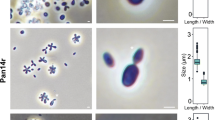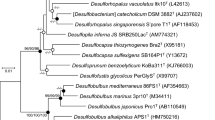Abstract
Microaerophilic veils of swimming microorganisms form at oxic-anoxic interfaces, mostly described in sediments where sulfide from below meets oxygen diffusing in from the water phase. However, microaerophilic veils form even when these gradients do not overlap, for example when cable bacteria activity leads to a suboxic zone. This suggests that veil microorganisms can use electron donors other than sulfide. Here we describe the extraction of microorganisms from a microaerophilic veil that formed in cable-bacteria-enriched freshwater sediment using a glass capillary, and the subsequent isolation of a motile, microaerophilic, organoheterotrophic bacterium, strain R2-JLT, unable to oxidize sulfide. Based on phenotypic, phylogenetic, and genomic comparison, we propose strain R2-JLT as a novel Phyllobacterium species, P. calauticae sp. nov.. The type strain is R2-JLT (= LMG 32286T = DSM 112555T). This novel isolate confirms that a wider variety of electron donors, including organic compounds, can fuel the activity of microorganisms in microaerophilic veils.



Similar content being viewed by others
Availability of data and material
P. calauticae R2-JLT is available from BCCM/LMG Gent, Belgium (LMG 32286T) and DSMZ, Braunschweig, Germany (DSM 112555T). The draft genome sequence is available from NCBI under the accession number JAGENB000000000.
References
Bankevich A, Nurk S, Antipov D, Gurevich AA, Dvorkin M et al (2012) SPAdes: a new genome assembly algorithm and its applications to single-cell sequencing. J Comput Biol 19(5):455–477. https://doi.org/10.1089/cmb.2012.0021
Barbara GM, Mitchell JG (1996) Formation of 30- to 40-micrometer-thick laminations by high-speed marine bacteria in microbial mats. Appl Environ Microbiol 62(11):3985–3990. https://doi.org/10.1128/aem.62.11.3985-3990.1996
Berner RA (1981) A new geochemical classification of sedimentary environments. J Sed Petrol 51(2):0359–0365. https://doi.org/10.1306/212F7C7F-2B24-11D7-8648000102C1865D
Bjerg JT, Boschker HT, Larsen S et al (2018) Long-distance electron transport in individual, living cable bacteria. PNAS 115(22):5786–5791. https://doi.org/10.1073/pnas.1800367115
Bjerg JT, Damgaard LR, Holm SA, Schramm A, Nielsen LP (2016) Motility of electric cable bacteria. App Environ Microbiol 82(13):3816–3821. https://doi.org/10.1128/AEM.01038-16
Bolger AM, Lohse M, Usadel B (2014) Trimmomatic: a flexible trimmer for Illumina sequence data. Bioinformatics 30(15):2114–2120. https://doi.org/10.1093/bioinformatics/btu170
Borisov VB, Gennis RB, Hemp J, Verkhovsky MI (2011) The cytochrome bd respiratory oxygen reductases. Biochim Biophys Acta 1807:1398–1413. https://doi.org/10.1016/j.bbabio.2011.06.016
Brune A, Frenzel P, Cypionka H (2000) Life at the oxic-anoxic interface: microbial activities and adaptations. FEMS Microbiol Rev 24:691–710. https://doi.org/10.1111/j.1574-6976.2000.tb00567.x
Camacho C, Coulouris G, Avagyan V et al (2009) BLAST+: architecture and applications. BMC Bioinformatics 10:421. https://doi.org/10.1186/1471-2105-10-421
Chaumeil PA et al (2020) GTDB-Tk: a toolkit to classify genomes with the Genome Taxonomy Database. Bioinformatics 36(6):1925–1927. https://doi.org/10.1093/bioinformatics/btz848
D’mello R, Hill S, Poole RK (1996) The cytochrome bd quinol oxidase in Escherichia coli has an extremely high oxygen affinity and two oxygen-binding haems: implications for regulation of activity in vivo by oxygen inhibition. Microbiology 142:755–763
Eddy SR (2011) Accelerated profile HMM searches. PLoS Comput Biol 7:e1002195
Emmerich R, Hennecke H, Fischer HM (2000) Evidence for a functional similarity between the two-component regulatory systems RegSR, ActSR, and RegBA (PrrBA) in alpha-Proteobacteria. Arch Microbiol 174:307–313. https://doi.org/10.1007/s002030000207
Flores-Félix JD, Carro L, Velázquez E, Valverde Á, Cerda-Castillo E, García-Fraile P, Rivas R (2013) Phyllobacterium endophyticum sp. nov., isolated from nodules of Phaseolus vulgaris. Int J Syst Evol Microbiol 63:821–826
Froelich PN, Klinkhammer GP, Bender ML, Luedtke NA, Heath GR, Cullen D, Dauphin P, Hammond D, Hartman B, Maynard V (1979) Early oxidation of organic matter in pelagic sediments of the eastern Equatorial Atlantic: suboxic diagenesis. Geochim Cosmochim Acta 43 1075–1090. https://doi.org/10.1016/0016-7037(79)90095-4
Goris J, Konstantinidis KT, Klappenbach JA, Coenye T, Vandamme P, Tiedje JM (2007) DNA-DNA hybridization values and their relationship to whole-genome sequence similarities. Int J System Evolution Microbiol. https://doi.org/10.1099/ijs.0.64483-0
Hsu JL, Chen HC, Peng HL, Chang HY (2008) Characterization of the histidine-containing phosphotransfer protein B-mediated multistep phosphorelay system in Pseudomonas aeruginosa PAO1. J Biol Chem 283:9933–9944. https://doi.org/10.1074/jbc.M708836200
Hyatt D, Chen G-L, LoCascio P, Land M, Larimer F, Hauser L (2010) Prodigal: prokaryotic gene recognition and translation initiation site identification. BMC Bioinf 11:119. https://doi.org/10.1186/1471-2105-11-119
Jain C, Rodriguez-R LM, Phillippy AM et al (2018) High throughput ANI analysis of 90K prokaryotic genomes reveals clear species boundaries. Nat Commun. https://doi.org/10.1038/s41467-018-07641-9
Jiao YS, Yan H, Ji ZJ, Liu YH, Sui XH, Zhang XX, Wang ET, Chen WX, Chen WF (2015) Phyllobacterium sophorae sp. nov., a symbiotic bacterium isolated from root nodules of Sophora flavescens. Int J Syst Evol Microbiol 65:399–406
Jurado V, Laiz L, Gonzalez JM, Hernandez-Marine M, Valens M, Saiz-Jimenez C (2005) Phyllobacterium catacumbae sp. nov., a member of the order ‘Rhizobiales’ isolated from Roman catacombs. Int J Syst Evol Microbiol 55:1487–1490
Kanehisa M, Goto S (2000) KEGG: Kyoto encyclopedia of genes and genomes. Nucleic Acids Res 28:27–30
Kanehisa M (2019) Toward understanding the origin and evolution of cellular organisms. Protein Sci 28:1947–1951
Kanehisa M, Sato Y, Morishima K (2016) BlastKOALA and GhostKOALA: KEGG tools for functional characterization of genome and metagenome sequences. J Mol Biol 428:726–731
Knösel D (1962) Prüfung von Bakterien auf Fähigkeit zur Sternbildung. Zentralbl Bakteriol Parasitenkd Infektionskr Hyg II Abt 116:79–100
Kumar S, Stecher G, Li M, Knyaz C, Tamura K (2018) MEGA X: molecular evolutionary genetics analysis across computing platforms. Mol Biol Evol 35:1547–1549
Lane DJ (1991) 16S/23S rRNA sequencing. In: Stackebrandt E, Goodfellow M (eds) Nucleic acid techniques in bacterial systematics. Wiley, Chichester, pp 115–175
León-Barrios M, Ramírez-Bahena MH, Igual JM, Peix A, Velázquez E (2018) Phyllobacterium salinisoli sp nov isolated from a Lotus lancerottensis root nodule in saline soil from Lanzarote. Int J Syst Evol Microbiol 68:1085–1089
Liang LX, Sun QW, Hui N, Zhang XX, Li LB, Liu L (2019) Phyllobacterium phragmitis sp. Nov., an endophytic bacterium isolated from Phragmites australis rhizome in Kumtag Desert. Antonie Van Leeuwenhoek 112(5):661–668. https://doi.org/10.1007/s10482-018-1195-5
Mantelin S, Saux MF, Zakhia F, Béna G, Bonneau S, Jeder H, Lajudie P, Cleyet-Marel JC (2006) Emended description of the genus Phyllobacterium and description of four novel species associated with plant roots: Phyllobacterium bourgognense sp. nov., Phyllobacterium ifriqiyense sp. nov., Phyllobacterium leguminum sp. nov. and Phyllobacterium brassicacearum sp. nov. Int J Syst Evol Microbiol 56:827–839
Matsen FA et al (2010) pplacer: linear time maximum-likelihood and Bayesian phylogenetic placement of sequences onto a fixed reference tree. BMC Bioinf 11:538
Mergaert J, Cnockaert MC, Swings J (2002) Phyllobacterium myrsinacearum (subjective synonym Phyllobacterium rubiacearum) emend. Int J Syst Evol Microbiol 52:1821–1823
Miller LD, Russell MH, Alexandre G (2009) Diversity in bacterial chemotactic responses and niche adaptation. Adv Appl Microbiol 66:53–75. https://doi.org/10.1016/S0065-2164(08)00803-4
Muyzer G, Yildirim E, van Dongen U, Kühl M, Thar R (2005) Identification of ‘Candidatus Thioturbo danicus’, a microaerophilic bacterium that builds conspicuous veils on sulfidic sediments. Appl Environ Microbiol 71:8929–8933. https://doi.org/10.1128/AEM.71.12.8929-8933.2005
Nielsen LP, Risgaard-Petersen N, Fossing H, Christensen PB, Sayama M (2010) Electric currents couple spatially separated biogeochemical processes in marine sediment. Nature 463(7284):1071–1074. https://doi.org/10.1038/nature08790
Parks DH, Imelfort M, Skennerton CT, Hugenholtz P, Tyson GW (2015) CheckM: assessing the quality of microbial genomes recovered from isolates, single cells, and metagenomes. Genome Res 25(7):1043–1055. https://doi.org/10.1101/gr.186072.114
Parks DH et al (2018) A standardized bacterial taxonomy based on genome phylogeny substantially revises the tree of life. Nature Biotechnol 36(10):996. https://doi.org/10.1038/nbt.4229
Pfeffer C, Larsen S, Song J, Dong M et al (2012) Filamentous bacteria transport electrons over centimetre distances. Nature 491(10–398):13. https://doi.org/10.1038/nature11586
Price MN, Dehal PS, Arkin AP (2009) FastTree: computing large minimum-evolution trees with profiles instead of a distance matrix. Mol Biol Evol 26:1641–1650. https://doi.org/10.1093/molbev/msp077
Price MN, Dehal PS, Arkin AP (2010) FastTree 2—approximately maximum-likelihood trees for large alignments. PLoS ONE 5(3):e9490. https://doi.org/10.1371/journal.pone.0009490
Rice CW, Hempfling WP (1978) Oxygen-limited continuous culture and respiratory energy conservation in Escherichia coli. J Bacteriol 134:115–124
Richter M, Rosselló-Móra R (2009) Shifting the genomic gold standard for the prokaryotic species definition. Proc Natl Acad Sci USA 106:19126–19131. https://doi.org/10.1073/pnas.0906412106
Safronova VI, Sazanova AL, Kuznetsova IG, Belimov AA, Andronov EE, Chirak ER, Popova JP, Verkhozina AV, Willems A, Tikhonovich IA (2018) Phyllobacterium zundukense sp. nov. a novel species of rhizobia isolated from root nodules of the legume species oxytropis triphylla (pall.) pers. Int J Syst Evol Microbiol 68:1644–1651
Sánchez M, Ramírez-Bahena MH, Peix A, Lorite MJ, Sanjuán J, Velázquez E, Monza J (2014) Phyllobacterium loti sp. nov. isolated from nodules of Lotus corniculatus. Int J Syst Evol Microbiol 64:781–786
Schauer R, Risgaard-Petersen N, Kjeldsen KU, Bjerg JJT, Jørgensen BB, Schramm A, Nielsen LP (2014) Succession of cable bacteria and electric currents in marine sediment. ISME J 8(6):1314–1322
Scilipoti S, Koren K, Risgaard-Petersen N, Schramm A, Nielsen LP (2021) Oxygen consumption of individual cable bacteria. Sci Adv 7(7):eabe1870. https://doi.org/10.1126/sciadv.abe1870
Seemann T (2014) Prokka: rapid prokaryotic genome annotation. Bioinformatics 30(14):2068–2069. https://doi.org/10.1093/bioinformatics/btu153
Sievers F, Wilm A, Dineen DG, Gibson TJ, Karplus K, Li W, Lopez R, McWilliam H, Remmert M, Söding J, Thompson JD, Higgins D (2011) Fast, scalable generation of high-quality protein multiple sequence alignments using Clustal Omega. Mol Syst Biol 7:539. https://doi.org/10.1038/msb.2011.75
Szurmant H, Bunn MW, Cannistraro VJ, Ordal GW (2003) Bacillus subtilis hydrolyzes CheY-P at the location of its action, the flagellar switch. J Biol Chem 278:48611–48616. https://doi.org/10.1074/jbc.M306180200
Thar R, Fenchel T (2005) Survey of motile microaerophilic bacterial morphotypes in the oxygen-gradient above a marine sulfidic sediment. Appl Environ Microbiol 71:3682–3691. https://doi.org/10.1128/AEM.71.7.3682-3691.2005
Thar R, Kühl M (2002) Conspicuous veils formed by vibrioid bacteria on sulfidic marine sediments. Appl Environ Microbiol 68:6310–6320. https://doi.org/10.1128/AEM.68.12.6310-6320.2002
Thorup C, Petro C, Bøggild A, Ebsen TS, Brokjær S, Nielsen LP, Schramm A, Bjerg JJ (2021) How to grow your cable bacteria: Establishment of a stable single-strain culture in sediment and proposal of Candidatus Electronema aureum GS. Syst Appl Microbiol 44(5):126236. https://doi.org/10.1016/j.syapm.2021.126236
Valverde A, Velázquez E, Fernández-Santos F, Vizcaíno N, Rivas R, Mateos PF, Martínez-Molina E, Igual JM, Willems A (2005) Phyllobacterium trifolii sp. nov., nodulating Trifolium and Lupinus in Spanish soils. Int J Syst Evol Microbiol 55:1985–1989
Wingett SW, Andrews S (2018) FastQ Screen: a tool for multigenome mapping and quality control. F1000 Res 7:1338. https://doi.org/10.12688/f1000research.15931.2
Acknowledgements
We thank Susanne Nielsen and Lars B. Pedersen for their work and support in the molecular and microbiological laboratories; Pia Bomholt Jensen for excellent SEM images; and Ronny Mario Baaske for care of the cable bacteria enrichments. This research was supported by the Danish National Research Foundation (DNRF136) and the Carlsberg Foundation (CF19-0666)
Funding
This research was supported by the Danish National Research Foundation (DNRF136) and the Carlsberg Foundation (CF19-0666).
Author information
Authors and Affiliations
Contributions
JL, JB, AS, and IM conceived and designed the study; JL and AS performed research; JL analysed data; JL, JB, and IM contributed new methods or models; JL, AS, and IM wrote the paper; all authors have read and approved the final manuscript.
Corresponding author
Ethics declarations
Conflicts of interest
The authors declare that they have no conflicts of interest.
Additional information
Publisher's Note
Springer Nature remains neutral with regard to jurisdictional claims in published maps and institutional affiliations.
Supplementary Information
Below is the link to the electronic supplementary material.
Rights and permissions
About this article
Cite this article
Lustermans, J.J.M., Bjerg, J.J., Schramm, A. et al. Phyllobacterium calauticae sp. nov. isolated from a microaerophilic veil transversed by cable bacteria in freshwater sediment. Antonie van Leeuwenhoek 114, 1877–1887 (2021). https://doi.org/10.1007/s10482-021-01647-y
Received:
Accepted:
Published:
Issue Date:
DOI: https://doi.org/10.1007/s10482-021-01647-y




